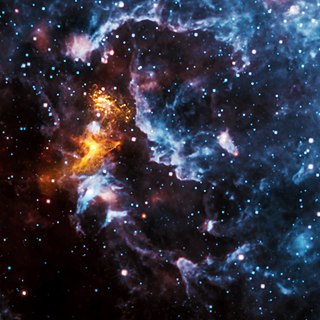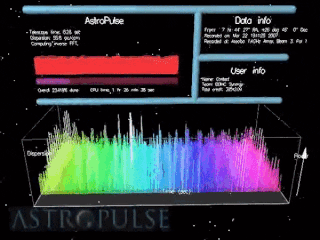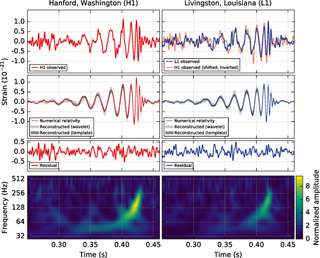An astronomical radio source is an object in outer space that emits strong radio waves. Radio emission comes from a wide variety of sources. Such objects are among the most extreme and energetic physical processes in the universe.

A pulsar is a highly magnetized rotating neutron star that emits beams of electromagnetic radiation out of its magnetic poles. This radiation can be observed only when a beam of emission is pointing toward Earth, and is responsible for the pulsed appearance of emission. Neutron stars are very dense and have short, regular rotational periods. This produces a very precise interval between pulses that ranges from milliseconds to seconds for an individual pulsar. Pulsars are one of the candidates for the source of ultra-high-energy cosmic rays.

A millisecond pulsar (MSP) is a pulsar with a rotational period less than about 10 milliseconds. Millisecond pulsars have been detected in radio, X-ray, and gamma ray portions of the electromagnetic spectrum. The leading hypothesis for the origin of millisecond pulsars is that they are old, rapidly rotating neutron stars that have been spun up or "recycled" through accretion of matter from a companion star in a close binary system. For this reason, millisecond pulsars are sometimes called recycled pulsars.

PSR J0737−3039 is the first known double pulsar. It consists of two neutron stars emitting electromagnetic waves in the radio wavelength in a relativistic binary system. The two pulsars are known as PSR J0737−3039A and PSR J0737−3039B. It was discovered in 2003 at Australia's Parkes Observatory by an international team led by the Italian radio astronomer Marta Burgay during a high-latitude pulsar survey.

Astropulse is a volunteer computing project to search for primordial black holes, pulsars, and extraterrestrial intelligence (ETI). Volunteer resources are harnessed through Berkeley Open Infrastructure for Network Computing (BOINC) platform. In 1999, the Space Sciences Laboratory launched SETI@home, which would rely on massively parallel computation on desktop computers scattered around the world. SETI@home utilizes recorded data from the Arecibo radio telescope and searches for narrow-bandwidth radio signals from space, signifying the presence of extraterrestrial technology. It was soon recognized that this same data might be scoured for other signals of value to the astronomy and physics community.
The gravitational wave background is a random background of gravitational waves permeating the Universe, which is detectable by gravitational-wave experiments, like pulsar timing arrays. The signal may be intrinsically random, like from stochastic processes in the early Universe, or may be produced by an incoherent superposition of a large number of weak independent unresolved gravitational-wave sources, like supermassive black-hole binaries. Detecting the gravitational wave background can provide information that is inaccessible by any other means about astrophysical source population, like hypothetical ancient supermassive black-hole binaries, and early Universe processes, like hypothetical primordial inflation and cosmic strings.

A binary pulsar is a pulsar with a binary companion, often a white dwarf or neutron star. Binary pulsars are one of the few objects which allow physicists to test general relativity because of the strong gravitational fields in their vicinities. Although the binary companion to the pulsar is usually difficult or impossible to observe directly, its presence can be deduced from the timing of the pulses from the pulsar itself, which can be measured with extraordinary accuracy by radio telescopes.

A gravitational-wave detector is any device designed to measure tiny distortions of spacetime called gravitational waves. Since the 1960s, various kinds of gravitational-wave detectors have been built and constantly improved. The present-day generation of laser interferometers has reached the necessary sensitivity to detect gravitational waves from astronomical sources, thus forming the primary tool of gravitational-wave astronomy.

Gravitational-wave astronomy is a subfield of astronomy concerned with the detection and study of gravitational waves emitted by astrophysical sources.

In cosmology, primordial black holes (PBHs) are hypothetical black holes that formed soon after the Big Bang. In the inflationary era and early radiation-dominated universe, extremely dense pockets of subatomic matter may have been tightly packed to the point of gravitational collapse, creating primordial black holes without the supernova compression typically needed to make black holes today. Because the creation of primordial black holes would pre-date the first stars, they are not limited to the narrow mass range of stellar black holes.
A pulsar timing array (PTA) is a set of galactic pulsars that is monitored and analysed to search for correlated signatures in the pulse arrival times on Earth. As such, they are galactic-sized detectors. Although there are many applications for pulsar timing arrays, the best known is the use of an array of millisecond pulsars to detect and analyse long-wavelength gravitational wave background. Such a detection would entail a detailed measurement of a gravitational wave (GW) signature, like the GW-induced quadrupolar correlation between arrival times of pulses emitted by different millisecond pulsar pairings that depends only on the pairings' angular separations in the sky. Larger arrays may be better for GW detection because the quadrupolar spatial correlations induced by GWs can be better sampled by many more pulsar pairings. With such a GW detection, millisecond pulsar timing arrays would open a new low-frequency window in gravitational-wave astronomy to peer into potential ancient astrophysical sources and early Universe processes, inaccessible by any other means.
The North American Nanohertz Observatory for Gravitational Waves (NANOGrav) is a consortium of astronomers who share a common goal of detecting gravitational waves via regular observations of an ensemble of millisecond pulsars using the Green Bank Telescope, Arecibo Observatory, the Very Large Array, and the Canadian Hydrogen Intensity Mapping Experiment (CHIME). Future observing plans include up to 25% total time of the Deep Synoptic Array 2000 (DSA2000). This project is being carried out in collaboration with international partners in the Parkes Pulsar Timing Array in Australia, the European Pulsar Timing Array, and the Indian Pulsar Timing Array as part of the International Pulsar Timing Array.
The International Pulsar Timing Array (IPTA) is a multi-institutional, multi-telescope collaboration comprising the European Pulsar Timing Array (EPTA), the North American Nanohertz Observatory for Gravitational Waves (NANOGrav), the Parkes Pulsar Timing Array (PPTA) in Australia, and the Indian Pulsar Timing Array Project (InPTA). The goal of the IPTA is to detect ultra-low-frequency gravitational waves, such as from mergers of supermassive black holes, using an array of approximately 30 pulsars. This goal is shared by each of the participating institutions, but they have all recognized that their goal will be achieved more quickly by combining their respective efforts and resources.

PALFA is a large-scale survey for radio pulsars at 1.4 GHz using the Arecibo 305-meter telescope and the ALFA multibeam receivers. It is the largest and most sensitive survey of the Galactic plane to date.

PSR J0348+0432 is a pulsar–white dwarf binary system in the constellation Taurus. It was discovered in 2007 with the National Radio Astronomy Observatory's Robert C. Byrd Green Bank Telescope in a drift-scan survey.

In radio astronomy, a fast radio burst (FRB) is a transient radio pulse of length ranging from a fraction of a millisecond, for an ultra-fast radio burst, to 3 seconds, caused by some high-energy astrophysical process not yet understood. Astronomers estimate the average FRB releases as much energy in a millisecond as the Sun puts out in three days. While extremely energetic at their source, the strength of the signal reaching Earth has been described as 1,000 times less than from a mobile phone on the Moon.

Matthew Bailes is an astrophysicist and Professor at the Centre for Astrophysics and Supercomputing, Swinburne University of Technology and the Director of OzGrav, the ARC Centre of Excellence for Gravitational Wave Discovery. In 2015 he won an ARC Laureate Fellowship to work on Fast Radio Bursts. He is one of the most active researchers in pulsars and Fast Radio Bursts in the world. His research interests includes the birth, evolution of binary and millisecond pulsars, gravitational waves detection using an array of millisecond pulsars and radio astronomy data processing system design for Fast Radio Burst discovery. He is now leading his team to re-engineer the Molonglo Observatory Synthesis Telescope with a newly designed correlation system for observation of pulsars and Fast Radio Bursts (FRBs).

The Canadian Hydrogen Intensity Mapping Experiment (CHIME) is an interferometric radio telescope at the Dominion Radio Astrophysical Observatory in British Columbia, Canada which consists of four antennas consisting of 100 x 20 metre cylindrical parabolic reflectors with 1024 dual-polarization radio receivers suspended on a support above them. The antenna receives radio waves from hydrogen in space at frequencies in the 400–800 MHz range. The telescope's low-noise amplifiers are built with components adapted from the cellphone industry and its data are processed using a custom-built FPGA electronic system and 1000-processor high-performance GPGPU cluster. The telescope has no moving parts and observes half of the sky each day as the Earth turns.

Ingrid Stairs is a Canadian astronomer currently based at the University of British Columbia. She studies pulsars and their companions as a way to study binary pulsar evolution, pulsar instrumentation and polarimetry, and Fast Radio Bursts (FRBs). She was awarded the 2017 Rutherford Memorial Medal for physics of the Royal Society of Canada, and was elected as a Fellow of the American Physical Society in 2018.

Duncan Ross Lorimer is a British-born American astrophysicist. He is a professor of astronomy at West Virginia University, known for the discovery of the first fast radio burst in 2007.













